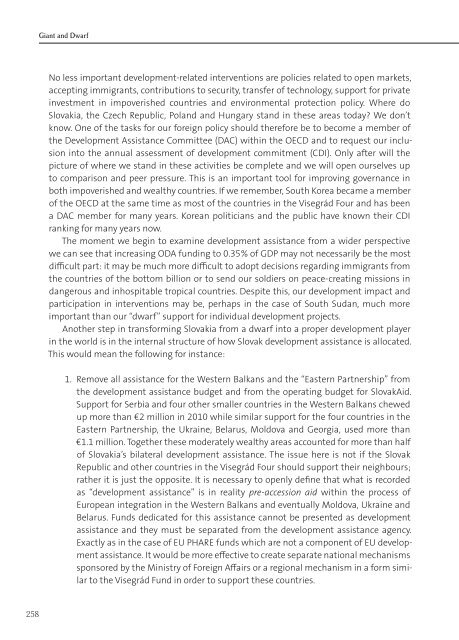Giant_and_Dwarf-FIN
Giant_and_Dwarf-FIN
Giant_and_Dwarf-FIN
Create successful ePaper yourself
Turn your PDF publications into a flip-book with our unique Google optimized e-Paper software.
<strong>Giant</strong> <strong>and</strong> <strong>Dwarf</strong>No less important development-related interventions are policies related to open markets,accepting immigrants, contributions to security, transfer of technology, support for privateinvestment in impoverished countries <strong>and</strong> environmental protection policy. Where doSlovakia, the Czech Republic, Pol<strong>and</strong> <strong>and</strong> Hungary st<strong>and</strong> in these areas today? We don’tknow. One of the tasks for our foreign policy should therefore be to become a member ofthe Development Assistance Committee (DAC) within the OECD <strong>and</strong> to request our inclusioninto the annual assessment of development commitment (CDI). Only after will thepicture of where we st<strong>and</strong> in these activities be complete <strong>and</strong> we will open ourselves upto comparison <strong>and</strong> peer pressure. This is an important tool for improving governance inboth impoverished <strong>and</strong> wealthy countries. If we remember, South Korea became a memberof the OECD at the same time as most of the countries in the Visegrád Four <strong>and</strong> has beena DAC member for many years. Korean politicians <strong>and</strong> the public have known their CDIranking for many years now.The moment we begin to examine development assistance from a wider perspectivewe can see that increasing ODA funding to 0.35 % of GDP may not necessarily be the mostdifficult part: it may be much more difficult to adopt decisions regarding immigrants fromthe countries of the bottom billion or to send our soldiers on peace-creating missions indangerous <strong>and</strong> inhospitable tropical countries. Despite this, our development impact <strong>and</strong>participation in interventions may be, perhaps in the case of South Sudan, much moreimportant than our “dwarf” support for individual development projects.Another step in transforming Slovakia from a dwarf into a proper development playerin the world is in the internal structure of how Slovak development assistance is allocated.This would mean the following for instance:1. Remove all assistance for the Western Balkans <strong>and</strong> the “Eastern Partnership” fromthe development assistance budget <strong>and</strong> from the operating budget for SlovakAid.Support for Serbia <strong>and</strong> four other smaller countries in the Western Balkans chewedup more than €2 million in 2010 while similar support for the four countries in theEastern Partnership, the Ukraine, Belarus, Moldova <strong>and</strong> Georgia, used more than€1.1 million. Together these moderately wealthy areas accounted for more than halfof Slovakia’s bilateral development assistance. The issue here is not if the SlovakRepublic <strong>and</strong> other countries in the Visegrád Four should support their neighbours;rather it is just the opposite. It is necessary to openly define that what is recordedas “development assistance” is in reality pre-accession aid within the process ofEuropean integration in the Western Balkans <strong>and</strong> eventually Moldova, Ukraine <strong>and</strong>Belarus. Funds dedicated for this assistance cannot be presented as developmentassistance <strong>and</strong> they must be separated from the development assistance agency.Exactly as in the case of EU PHARE funds which are not a component of EU developmentassistance. It would be more effective to create separate national mechanismssponsored by the Ministry of Foreign Affairs or a regional mechanism in a form similarto the Visegrád Fund in order to support these countries.258


